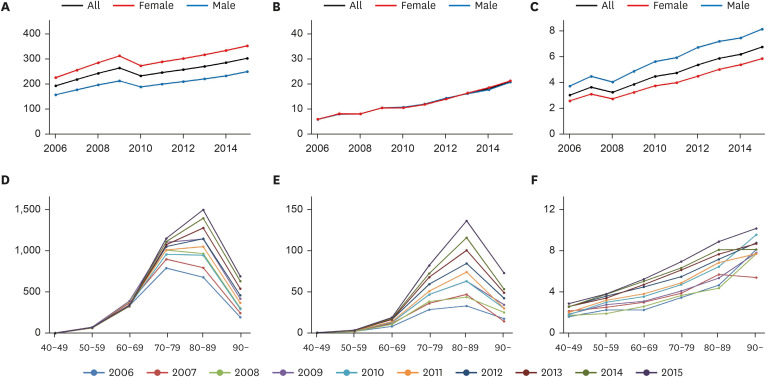J Korean Med Sci.
2023 Apr;38(15):e114. 10.3346/jkms.2023.38.e114.
Dysphagia Requiring Medical Attention in Parkinson’s Disease: A Korean Population-Based Study
- Affiliations
-
- 1Department of Rehabilitation Medicine, Seoul National University College of Medicine, Seoul National University Bundang Hospital, Seongnam, Korea
- 2Department of Statistics and Actuarial Science, Soongsil University, Seoul, Korea
- KMID: 2541553
- DOI: http://doi.org/10.3346/jkms.2023.38.e114
Abstract
- Background
Patients with Parkinson’s disease (PD) experience both motor and non-motor symptoms, including dysphagia. Although PD is closely associated with dysphagia, the prevalence or risk of dysphagia in PD is unclear, especially in Asian countries.
Methods
The prevalence of PD and dysphagia with PD in the general population was analyzed using the Korean National Health Insurance Service (NHIS) database. The prevalence per 100,000 persons of PD and dysphagia with PD from 2006 to 2015 was analyzed in the general population aged ≥ 40 years. Patients newly diagnosed with PD between 2010 and 2015 were compared with those without PD.
Results
The prevalence of PD and dysphagia in patients with PD increased continuously during the study period and was highest in the ninth decade of life. The percentage of patients with dysphagia in patients with PD increased with age. Patients with PD showed an adjusted hazard ratio of 3.132 (2.955–3.320) for dysphagia compared to those without PD.
Conclusion
This nationwide study showed increasing trends in the prevalence of PD and dysphagia among patients with PD in Korea between 2006 and 2015. The risk of dysphagia was three times higher in patients with PD than that in those without PD, highlighting the importance of providing particular attention.
Figure
Reference
-
1. Pringsheim T, Jette N, Frolkis A, Steeves TD. The prevalence of Parkinson’s disease: a systematic review and meta-analysis. Mov Disord. 2014; 29(13):1583–1590. PMID: 24976103.2. Schapira AH, Chaudhuri KR, Jenner P. Non-motor features of Parkinson disease. Nat Rev Neurosci. 2017; 18(7):435–450. PMID: 28592904.3. Choi JH, Kim JM, Yang HK, Lee HJ, Shin CM, Jeong SJ, et al. Clinical perspectives of Parkinson’s disease for ophthalmologists, otorhinolaryngologists, cardiologists, dentists, gastroenterologists, urologists, physiatrists, and psychiatrists. J Korean Med Sci. 2020; 35(28):e230. PMID: 32686370.4. Yang EJ, Kim MH, Lim JY, Paik NJ. Oropharyngeal Dysphagia in a community-based elderly cohort: the Korean longitudinal study on health and aging. J Korean Med Sci. 2013; 28(10):1534–1539. PMID: 24133362.5. Altman KW, Yu GP, Schaefer SD. Consequence of dysphagia in the hospitalized patient: impact on prognosis and hospital resources. Arch Otolaryngol Head Neck Surg. 2010; 136(8):784–789. PMID: 20713754.6. Kalf JG, de Swart BJ, Bloem BR, Munneke M. Prevalence of oropharyngeal dysphagia in Parkinson’s disease: a meta-analysis. Parkinsonism Relat Disord. 2012; 18(4):311–315. PMID: 22137459.7. Yoon SY, Shin J, Chang JS, Lee SC, Kim YW. Effects of socioeconomic status on mortality after Parkinson’s disease: a nationwide population-based matched cohort study in Korean populations. Parkinsonism Relat Disord. 2020; 80:206–211. PMID: 33129703.8. Jung I, Kwon H, Park SE, Han KD, Park YG, Rhee EJ, et al. The prevalence and risk of type 2 diabetes in adults with disabilities in Korea. Endocrinol Metab (Seoul). 2020; 35(3):552–561. PMID: 32693567.9. Chaudhuri KR, Healy DG, Schapira AH. National Institute for Clinical Excellence. Non-motor symptoms of Parkinson’s disease: diagnosis and management. Lancet Neurol. 2006; 5(3):235–245. PMID: 16488379.10. Braak H, Del Tredici K, Rüb U, de Vos RA, Jansen Steur EN, Braak E. Staging of brain pathology related to sporadic Parkinson’s disease. Neurobiol Aging. 2003; 24(2):197–211. PMID: 12498954.11. Ko EJ, Chae M, Cho SR. Relationship between swallowing function and maximum phonation time in patients with parkinsonism. Ann Rehabil Med. 2018; 42(3):425–432. PMID: 29961740.12. López-Liria R, Parra-Egeda J, Vega-Ramírez FA, Aguilar-Parra JM, Trigueros-Ramos R, Morales-Gázquez MJ, et al. Treatment of dysphagia in Parkinson’s disease: a systematic review. Int J Environ Res Public Health. 2020; 17(11):4104. PMID: 32526840.13. Kwon M, Lee JH. Oro-pharyngeal dysphagia in Parkinson’s disease and related movement disorders. J Mov Disord. 2019; 12(3):152–160. PMID: 31556260.14. Savica R, Grossardt BR, Bower JH, Ahlskog JE, Rocca WA. Time trends in the incidence of Parkinson disease. JAMA Neurol. 2016; 73(8):981–989. PMID: 27323276.15. Yamawaki M, Kusumi M, Kowa H, Nakashima K. Changes in prevalence and incidence of Parkinson’s disease in Japan during a quarter of a century. Neuroepidemiology. 2009; 32(4):263–269. PMID: 19209006.16. Park JH, Kim DH, Kwon DY, Choi M, Kim S, Jung JH, et al. Trends in the incidence and prevalence of Parkinson’s disease in Korea: a nationwide, population-based study. BMC Geriatr. 2019; 19(1):320. PMID: 31752705.17. Nienstedt JC, Bihler M, Niessen A, Plaetke R, Pötter-Nerger M, Gerloff C, et al. Predictive clinical factors for penetration and aspiration in Parkinson’s disease. Neurogastroenterol Motil. 2019; 31(3):e13524. PMID: 30548367.
- Full Text Links
- Actions
-
Cited
- CITED
-
- Close
- Share
- Similar articles
-
- Oro-Pharyngeal Dysphagia in Parkinson's Disease and Related Movement Disorders
- Dysphgia in Parkinson’s Disease
- A Perspective of the Wearing-off Phenomenon in a Patient with Parkinson’s Disease: A Case Report
- Kinematic Analysis of Hyo-laryngeal Complex in Parkinson’s Disease
- Assessment of Oropharyngeal Dysphagia in Patients With Parkinson Disease: Use of Ultrasonography


